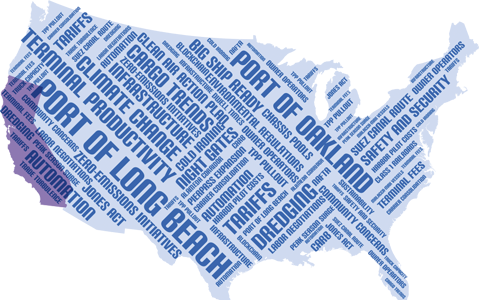Federal government transport policy needed for West Coast ports, say executive directors
Port of Long Beach Executive Director Mario Cordero and Oakland counterpart Chris Lytle called for government aid and policy direction.

In statements made at the recent “Ports & Terminals” luncheon in Oakland, two prominent port executives maintain that continued government support for maritime industry clean air efforts and infrastructure development remains a priority.
The Pacific Transportation Association hosts the annual event, which provides a forum for logistics professionals to share market intelligence with their peers.
Port of Long Beach Executive Director Mario Cordero and Oakland counterpart Chris Lytle called for government aid and policy direction.
Both are needed, they said, for the industry to digest global trade growth while further curbing freight transport diesel emissions.
“In California, we have the cleanest ports in the world,” said Lytle, who was Long Beach’s Executive Director before coming to Oakland. “But we could use help if we’re going to do more.”
Cordero, former Chairman of the Federal Maritime Commission, echoed this sentiment, saying “we’ll be as successful as government support allows us to be.”
As reported in LM, both ports have spent much of the decade improving port infrastructure to accommodate larger vessels and greater containerized cargo volume.
They’ve also developed new guidelines to more aggressively curb diesel emissions. The goal: bring exhaust emissions from containerized cargo transport to zero – or nearly zero.
Both port directors expressed gratitude for government grants supporting current clean air programs. Long Beach said it has reduced diesel particulate emissions 88 percent in the past decade. Oakland has reported a 76 percent reduction.
More aid is needed to advance the clean air effort, Lytle said.
The executive directors said policy guidance in Washington, D.C., would help, too.
Lytle called for nationwide clean air regulations to bring ports elsewhere up to California standards. Cordero said the U.S. needs a national freight policy to make port infrastructure a government priority.
Roads, bridges and rail networks must be upgraded to keep international supply chains functional, Cordero said.
Lytle agreed, pointing to the example of Seventh Street in the Port of Oakland. Freight rails and trucks intersect at the major Port thoroughfare, he said. The Alameda County Transportation Commission is spearheading a $500 million effort to separate them.
The project will include tunnels, overpasses and new traffic-control technology. When it’s completed, a freight-transport bottleneck “will disappear,” Lytle said.
“We can’t afford to do this ourselves,” Lytle said. “We rely on government top help and in this case, they’ve really stepped up.”
Fitch Ratings, one of the top three U.S. credit analysis agencies, recently affirmed the Port of Long Beach’s “AA” ratings on its outstanding debt of $993 million. The company also affirmed the Port’s “AA-” rating on a $325 million subordinate federal Transportation Infrastructure Finance and Innovation Act loan yet to be drawn. The AA rating – the highest for U.S. ports – reflects the Port of Long Beach’s strong market position, resilient long-term revenues, well-managed capital program and robust cash reserves.
Fitch Ratings Senior Director Emma Griffith, recently told LM that more regional cooperation would is needed.
“The ports of Los Angeles and Long Beach have avoided ‘a race to the bottom’ by cooperating in joint marketing and outreach efforts,” she said, “even though they continue to compete for cargo business.”
The Northwest Seaport Alliance, comprising the ports of Seattle and Tacoma, is another promising example of this, she added.

Article Topics
Ports News & Resources
U.S.-bound import growth track remains promising, notes Port Tracker report Q&A: Port of Oakland Maritime Director Bryan Brandes Signs of progress are being made towards moving cargo in and out of Baltimore New Breakthrough ‘State of Transportation’ report cites various challenges for shippers and carriers in 2024 Industry experts examine the impact of Baltimore bridge collapse on supply chains Port of Baltimore closed indefinitely to ships after 1.6-mile Key Bridge collapses following maritime accident February and year-to-date U.S. import growth is solid, reports S&P Global Market Intelligence More PortsLatest in Logistics
FTR Shippers Conditions Index enters negative territory DAT March Truckload Volume Index sees modest March gains National diesel average, for week of April 22, is down for the second straight week UPS reports first quarter earnings declines LM Podcast Series: Assessing the freight transportation and logistics markets with Tom Nightingale, AFS Logistics Investor expectations continue to influence supply chain decision-making The Next Big Steps in Supply Chain Digitalization More LogisticsAbout the Author
Subscribe to Logistics Management Magazine

Find out what the world's most innovative companies are doing to improve productivity in their plants and distribution centers.
Start your FREE subscription today.
April 2023 Logistics Management

Latest Resources














